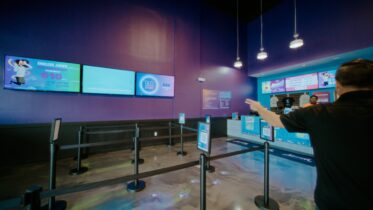As bank branch transformation advances, vibrant and innovative digital signage can serve as the middle ground between the digital and physical worlds. With proper strategy execution, these versatile platforms can introduce relevant promotions, products and services; facilitate engagements; convey brand imagery; and intuitively instill familiarity. Tactical application of media content strategy is a dynamic process requiring active analysis an d continuous adjustment to derive best results.
Integrate Non-Bank and Bank Related-Content
There are two types of media content banks can feature: bank-related content and non-bank related content. The latter, which features things like local weather, stock market updates, news headlines and trivia, is meant to keep customers’ eyeballs engaged long enough for the bank-related content to loop around. Non-bank content adds levity and prevents overloading customers with too much marketing. A mix of 75 percent banking-related and 25 percent non-banking content is a widely adopted ratio, notes Visible Banking.
True Customer-Centric Media Content
As much as banks claim to adopt the customer-centric model, the majority of their content still centers on delivering their products to a general audience in a one-shot-fits-all approach. While general bank content is a necessity, a true customer-centric model considers the needs of each demographic of customer, from baby boomers to Generation X, millennials and Generation Z. Each of these demographics has distinctly different lifestyles, needs and values for which the bank can provide relevant and applicable solutions.
How Retail Banks Can Thrive in Today's Digital Age
Explore short- and long-term opportunities to transform brick-and-mortar branch experiences. Download Now
Matched Content Improves Results
For the most impact, banks should match content to demographic. It’s best to tailor bank-related content into four target groups:
- General content should include up-to-date information on the basic gateway products like checking and savings accounts, CD and money market rates, home and auto finance rates as well as any timely bank promotions.
- Baby boomer content should apply to retirees looking for conservative fixed-income generation products like money markets, treasury bills, insurance and estate planning with seasoned wealth management specialists.
- Generation X content should target mid-to-senior career customers and business owners with a combination of small business products, loans/refinance, retirement planning and wealth management services.
- Millennial content should focus on building credit and establishing foundations with various loan programs, robo-advisory and financial planning products, plus gateway wealth management services.
Analyze Demographic-Based Traffic Patterns
Additionally, banks should examine their traffic patterns to determine the specific days and times that have the heaviest traffic. Taking it one step further, an analysis of traffic by demographic would reveal the most useful insights pertaining to the timing of the targeted content.
If a determination can be made when the most traffic occurs by demographic, then the matched media content can be programmed to loop around those times more actively. Optimizing individual branch analytics can help accelerate bank branch transformation and increase customer engagement.
Effective Placement for Digital Signage in Banks
For maximum reach, placement of digital signage around the bank lobby is paramount. Additionally, aligning media content specifically to associated activity areas can intuitively bond purposes and instill familiarity throughout the bank.
Transaction areas like bank teller windows can run content that can elicit inquiries such as time-sensitive promotions and offers. Digital signage should be placed behind the tellers. Sit-down waiting areas can run content that informs and educates on bank products and services. And self-service kiosk and ATM areas can transmit content highlighting exciting upcoming technological innovations like AI-powered assistants that accentuate the brand as a leader on the digital forefront.
The Seven-Minute Sweet Spot
Customer migration to mobile and online banking platforms has caused sharp declines in retail bank branch foot traffic. The scarcity of these visits has raised the stakes and the value of each and every customer engagement. The bank teller waiting line is the recurring “sweet spot” for optimal exposure to a temporarily captive audience. The average retail banking customer makes two branch visits a month, according to Accenture, and spends approximately seven minutes in the teller line.
Relevant transaction-related content like current and time-sensitive promotions should be set to rotate two to three times during the seven-minute waiting period.
The best-case outcome is to pique enough interest to compel a customer to inquire further about the promotion at the teller window. From here, the customer can be set up with a specialist for high-touch engagement and potential onboarding.
Maintenance Is Key
Nothing sends a message of complacency and apathy like malfunctioning signage or kiosks displaying an error message for all to see. In these cases, it’s best to turn off the displays until they can be repaired. Don’t treat digital signage as televisions or simple replacements for static signs by transmitting only static images.
Banks are looking to digital transformation to help their customers see them as innovative, cutting-edge and responsive. Digital signage in banks, paired with targeted content, plays a direct role in conveying and reinforcing this brand image in an unobtrusive and visually stimulating dynamic medium.
Looking for more exciting technology to spur bank branch transformation? Explore our full line of FinTech solutions.









